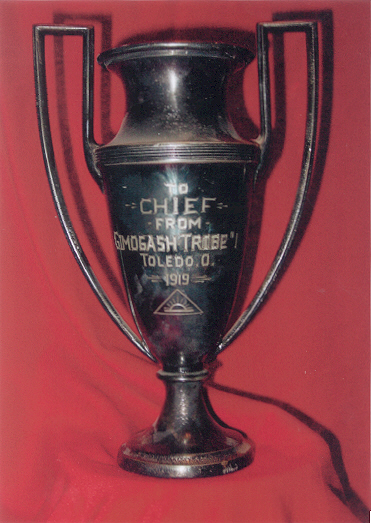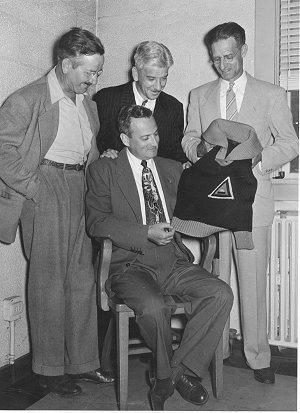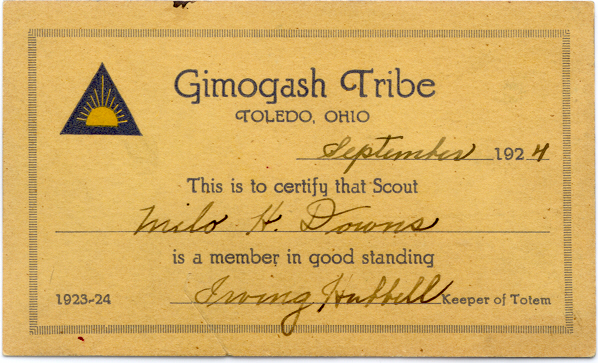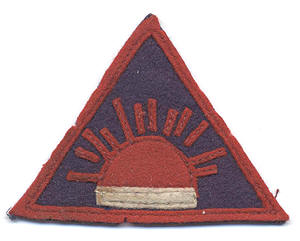|
Toledo did have a camp honor program that is known to have existed in 1915
(it is featured in their 1915 camp manual) called the Order of the Mystic Circle. Mendenhall may have brought this from Kansas City when he arrived. I
am told Mr. Mendenhall was the fourth or fifth Eagle Scout in the country
although I have never confirmed it. Much has been written about Gimogash and
the program existed in reportedly dozens of councils. Gimogash was created
to try to spark interest in older boys to stay in scouting.
The word Gimogash meant "the silent power" which was service to others. The
original Gimogash in Toledo heavily stressed service and many examples are
noted in a 1918 Toledo Council yearbook. There were three degrees of
Gimogash. First Degree was for First Class Scouts, Second Degree was for
Life & Star Scouts and Third Degree was for Eagle Scouts. Each scout
received an emblem (patch), pin and stationary. To be eligible to join, you
had to be at least first class rank, 15 years old (and not yet 21), active
in a troop at least six months, have five merit badges, respond to at least
five calls for service and register at council headquarters for service.
According to an article in the very first issue of the Toledo Council
newsletter (The Toledo Scout)dated February 20, 1915, members of Gimogash
had to earn a merit badge a month to maintain their membership. The Gimogash
troop met the first and third Monday of each month from 7:30-9pm. Membership
was on top of your regular troop membership.
Gimogash was a group that seemed to have a lot of "3's" within it. The patch
was three sided and there were three focal points (honor, leadership and
service). The initiation ceremony used three tipis placed in a triangle with
three containers containing three substances and had three Indians involved.
Besides the initiation ritual there was a ceremony after each degree. The
layout of the initiation ceremony was quite interesting as it cryptically
created the patch design when viewed from above. Potential members were
recommended by their scout leader to the Gimogash group then the Gimogash
discussed his attitude and service record. If elected, he reported to camp
where he spent the night and then worked at different tasks throughout the
day on Saturday with little food (like the OA). Candidates for the
initiation ritual were roped together then taken single file to the council
area. Here the candidate made his final preparation and as he was led to the
final area a hidden Gimogash member would make the sound of an owl. The
final area had three Tipis set up in a triangle formation with a small fire
burning in front of the center one between the two other tipis. (From a
birdseye view it was the triangular Gimogash patch with the fire being the
rising sun). The Gimogash chief (in full regalia) would be standing in front
of the rear centered Tipi with two assistant chiefs (also in full regalia)
in front of the two forward Tipis. There would be three one gallon cans
buried into the ground between the fire and the Chiefs. One can was filled
with hot wood ashes, one with water and one with dirt. The candidate would
dip his hand into each one. The hot ash can was to show bravery, the water
to show a scout is clean in body and speech and the dirt to show that he
will return to the earth from which he came. After this they were given
their membership patch and taken to a feast. Each degree required besides
the rank advancement, recruiting and training five new Tenderfoot scouts and
a specified number of hours of service. This was five new Tenderfoot scouts
for EACH degree.
To reward the members for the service they provided there
was an annual trip. To go you had to be an Eagle scout, recruit and train
five additional Tenderfoot scouts (on top of the 15 already recruited),
serve five troops in a major capacity and serve the council headquarters in
five special tasks. Nineteen Eagle scouts attended the 1919 trip touring 50
large cities and 10 states with the trip lasting 23 days. The 1920 trip was
to Michigan's Upper Peninsula wilderness.
A Gimogash handbook was published
after November 1, 1919 and before the planned 1920 trip by the Toledo Area
Council. The original Toledo Gimogash advisor was not Mendenhall but was an
individual named Will Schroeder. He held the position for three years then
Louis R. Schenck was appointed advisor. (In the Summer 1995 issue of The
Journal, a private scouting historical publication, Schenck has been
misidentified as J. St. Clair Mendenhall in the Gimogash article that was
published.) Mendenhall resigned from the Toledo Council on September 1,
1919. His assistant, Ray Loftus, replaced him on a temporary basis until
Paul B. Samson was hired on November 1, 1919. Mr. Samson was the executive
of the Washtenaw-Livingstone Council in Ann Arbor, Michigan.

Click on Image to See Full Size
The Scouter that is top row, 4th from the right, was Paul Samson who was the Toledo executive who followed J. St. Clair Mendenhall in 1919. He was credited with spreading Gimogash to the most councils. I believe he was there through 1922. He was hired from Ypsilanti Michigan (by Ann Arbor) where he had been their exec. The Scouter 6th from the right (wearing glasses looking straight forward) was the Gimogash Advisor, Louis R. Schenck. Mendenhall is not in the photo. From the 1920 Gimogash Handbook.
"Under Chief
Samson, Gimogash had it's greatest growth and several tribes were organized
in other scout councils, with boys and leaders coming to Toledo for the
initiation. Eagle Scout trips, which had started with an automobile tour to
the east coast and back under Mr. Mendenhall, were resumed under Mr. Samson.
The best known were the canoe trips down the Ausable River from Grayling, MI
to Oscoda, MI." (quoted from a Toledo Council history booklet)Tribes that
were started in other councils traveled to Toledo to receive the initial
induction ceremony. The Scranton Tribe did this in 1921 when they started.
Gimogash had already spread to a number of cities by 1919 as a two day
sectional Gimogash conference was held in Toledo. It was attended by an
unspecified number of cities. In that same year, and perhaps at that conference,
the Gimogash Cup, pictured below, was presented to J. St. Clair Mendenhall.
The cup is inscribed "To Chief From Gimogash Tribe #1, Toledo Ohio 1919" and has the Gimogash patch engraved into it as well. It is a rather heavy solid sterling silver cup that has patina on it making it the black color.

New troops in Toledo had a Gimogash member as
an advisor for a month or so to help get it on it's feet. One rather unusual
thing I just discovered was that the youth members of the Toledo Gimogash
had a hat patch about three inches wide at the base that was worn on the
front of their campaign hats. In a large group picture taken in April, 1918
of a Middle West Scout Conference held in Toledo, the members of Gimogash
are included in the group with at least four having the patch on their hat.
There was also a large patch that was worn on a sweater. Anyone who has come
across a hat patch probably assumes they have a pocket patch although it
doesn't appear that such a thing existed in the early days of Gimogash at
Toledo. The Journal article states that "All versions of this emblem were
basically the same design. The symbol of Gimogash is a white triangle with a
black inner triangle and a rising sun colored orange on a blue background".
The 1918 yearbook has a full color picture of the emblem and it is a black
outer triangle with a blue inner triangle with a yellow rising sun with a
black bar under the sun. There are 13 rays coming off the sun. Athough the
picture showing the hat patch is black and white, there is no outer white
triangle that can be seen. The outer triangle appears to be black or is a
very dark color. The sweater patch however has a white outer triangle.
Perhaps some of the hat patches have been found and labeled fakes because of
having no white triangle. I do not know.
The following is quoted directly from the 1920 Toledo Gimogash handbook...
"The establishment of chapters in other cities increases the attractiveness
of the plan and gives life to the expression, 'a scout is a brother to every
other scout'. However, there shall be no national organization including in
its membership local chapters of Gimogash, nor any part national or district
organization. Scouting is a movement, not an organization - a training - not
a club - Gimogash aims to be only a training, an additional program in
scouting - and not a distinct organization." The Gimogash people did not
want the group to be a seperate national organization or to become "bigger
than scouting". It appears this viewpoint was written by Mr. Samson and not
Mr. Mendenhall as earlier thought. It should be noted that this philosophy
allowed Gimogash to automatically fall within the guidelines set forth at
the 1922 Professional Scouters National Meeting concerning scout honor
groups.
 Close-up of Sweater
This photo is of four of the original Gimogash members of Toledo Gimogash. They were members during the Mendenhall era of 1914-1919. The sweater would be one of the originals. One of them was an editor for the Toledo Blade newspaper. He accompanied Admiral Byrd during one of his expeditions to the south pole as an Eagle Scout. Paul Siple was the first Eagle to do this. Close-up of Sweater
This photo is of four of the original Gimogash members of Toledo Gimogash. They were members during the Mendenhall era of 1914-1919. The sweater would be one of the originals. One of them was an editor for the Toledo Blade newspaper. He accompanied Admiral Byrd during one of his expeditions to the south pole as an Eagle Scout. Paul Siple was the first Eagle to do this.
Below is a membership card from Toledo dated 1924.

Gimogash existed in Parkersburg, W. Virginia; Bay City, Michigan; Flint,
Michigan; Toledo, Ohio; Scranton, Pennsylvania (1921-1966); Dayton, Ohio;
Danville, Illinois; Terre Haute, Indiana; Louisville, Kentucky; Holland,
Michigan; Logansport, Indiana; Elkhart, Indiana and probably other locations
still forgotten.
It is still unknown at what point Gimogash died out in Toledo and why. It is
known that Toledo had a chapter of the Knights of Dunamis for a number of
years. Perhaps the Knights were brought in by a council executive and that
displaced Gimogash. The Eagle trips lasted for many years but it was the
Knights that was the group doing the later ones. Considering that Gimogash
had many Eagles and the Knights were strictly an Eagle Scout society that
may be the answer to what happened to Gimogash although this is in no way
confirmed but simply conjecture at this point. Toledo did not start the OA
program until 1958, long after most of the rest of the country was using it.
Mohican Tribe of Gimogash - Created in 1921 in Scranton, Pennsylvania it
existed until about 1966 when it was displaced by the OA. The original OA
organizational meeting was held October 1, 1958. The Scranton Gimogash was
created after the Council Executive (Donald Gulick), Council Secretary and
three scouts made a trip to Toledo to investigate the organization. This
group was reportedly the last of the many Gimogash locations that once
existed. There were two versions of their small patch. The original was cut
with metal dies then apparently in the 1940's they (the dies) were lost and
the patches were hand cut (and appear to be handmade) after that. The
original patches were black border,light blue inner triangle, orange sun,
three orange rays and black bar. The newer patch was smaller than the
original. These patches were worn on the top of the left sleeve in the
1920's and later were worn on the scout campaign hats until they went out of
style in the late 1940's, then were worn on the pocket. Members also had a
pin which was a colloid triangle with the black bar and rising sun. The
group burned their ceremonial costumes in a fire but this was not done as
some sort of protest against the OA. They had been stored in a wet condition
and got ruined from it and couldn't be saved so the members simply burned
them. It has been reported in other accounts that this was done in anger. A
former Gimogash chief who was there has given the information of the wet
storage. As I understand it though, the surviving members still refuse to
join the OA. The membership of the Scranton Tribe of Gimogash group (called
the Mohican Tribe) was 240 with 46 of them being considered active according
to minutes of the initial "Order of the Arrow-Gimogash Meeting" held on July
24, 1958. The meeting was to consider starting up the OA. The minutes
further state that most of the Gimogash members were adults and that members
were chosen by existing members. The last paragraph of the meeting minutes
states that "There seemed to be no question but that the two organizations,
involving as they do, entirely difficult (a typo, I believe) age groups,
could not both exist and carry on traditional activities side by side." It
then ends with "All were most pleased with the outcome of the meeting".
Minutes of the OA organizational meeting on October 1, 1958 state that "It
was reported that the Gimogash in their September meeting endorsed the
formation of an Order of the Arrow Lodge...", then went on to say "It was
generally thought that this was a very fine development". Both sets of
minutes were written by the Council Executive of that time period. There
were eight existing OA members in the council when the decision was made to
go with the OA. There exists at the current council's camp a flag pole
installed in 1966 that has an engraved plate on it that says "Presented by
the Mohican Tribe of Gimogash". It has been reported that the last of the
Gimogash treasury was used to purchase this flagpole as well as a second
permanent one and two portable ones for the camp chapel. It is also reported
the group never technically dissolved itself, they just quit meeting. There
are a number of it's brethren still around.
Notes regarding the images: The patch image is taken directly from the 1918 Toledo Council Victory
yearbook. The other is a picture of J. St. Clair Mendenhall taken in 1918.
He was the creator of Gimogash.
Another website with information about Gimogash
Additional Information - After Gimogash's founder, J. St Clair Mendenhall, was hired as the exec of Kansas City in 1912 and received the Eagle Scout award in 1913 so he would have been about 22 years old when he received it. After he resigned from Scouting and left Toledo in 1919, he went to New York and became the director of Junior Achievement for New York City and later was a field director for the organization. He retired as a teacher in Northville, N.Y . where he taught industrial arts after WWII. He died on October 28, 1967 at age 76. He is buried in Riverside Cemetary in Coxsackie, N.Y.
Paul Samson, who followed him in Toledo as exec and is credited with really expanding Gimogash, died 13 days after Mendenhall at age 88 in Michigan.
Reader Contribution
Dave
The information you put together concerning the Tribe of Gimogash is really
great. I wanted to write you to provide you with some additional information.
The Tribe of Gimogash was also used in Middletown, Ohio. I have seen old
newspaper articles from Middletown talking about Gimogash activities.
Unfortunately I do not have a copy or scan of any of the articles to send you.
Also, I have attached a scan of a Gimogash patch I obtained from an estate
auction of Pearl Whitehead. As I understand it, he was a scouter from Dayton, OH
who was also very active on the region level. The patch is 3" on each side.

I hope you find this useful information.
Thanks
Bill Gray
Material found on this page is the work of David L. Eby and used USSSP, Inc. by permission. This material may not be reproduced without the express permission of David L. Eby
|




